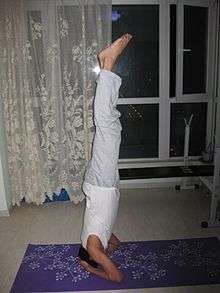Shirshasana


Sirsasana, Shirshasana (sher-SHAH-sahn-ah[1]; Sanskrit: शीर्षासन; IAST: Śīrṣāsana), Sirshasana, or Headstand is an asana.
In the Supported Headstand (Salamba Sirasana),[2] the body is completely inverted, and held upright supported by the forearms, while the crown of the head rests lightly on the floor.
Sirsasana is nicknamed "king" of all the asanas.[3][4][5][6][7]

A variety of other asanas can be used to build the upper body strength and balance required for Sirsasana.[8]
Etymology
The name comes from the Sanskrit words Shirsha (शीर्ष, Śīrṣa) meaning "head",[9] and Asana (आसन, Āsana) meaning "posture" or "seat".[10]
Contraindications and cautions
The asana is contraindicated in the following situations: high blood pressure,[11] heart palpitations, glaucoma,[11] detached retina, conjunctivitis, brain disease, brain injury, menstruation,[8] severe hypotension or hypertension,[8] hiatal hernia,[8] obesity, neck injury, and back injury.
Variations
See also
References
- ↑ Budilovsky, Joan; Adamson, Eve (2000). The complete idiot's guide to yoga (2 ed.). Penguin. p. 173. ISBN 978-0-02-863970-3. Retrieved 11 April 2011.
- ↑ "Yoga Journal - Supported Headstand". Retrieved 2011-04-11.
- ↑ Iyengar, B. K. S. (1970). Light on yoga: yoga dīpikā. Schocken Books. p. 127. Retrieved 11 April 2011.
... Sirsasana the king of all asanas and the reasons are not hard to find.
- ↑ Iyengar, Geeta (1 June 1998). Yoga: A Gem for Women. Allied Publishers. p. 187. ISBN 978-81-7023-715-0. Retrieved 11 April 2011.
Sirsasana is termed the 'King of Asanas'.
- ↑ Hoare, Sophy (1977). Yoga. Macdonald Educational. p. 78. ISBN 978-0-356-06012-5. Retrieved 11 April 2011.
Sirsasana is traditionally known as the king of the Asanas. As in Sarvangasana, the upside-down position benefits the entire body : the force of gravity pulling in the opposite direction from usual has a ...
- ↑ Ramdev, Swami (1 March 2006). Yog: Its Philosophy & Practice. Diamond Pocket Books (P) Ltd. p. 92. ISBN 978-81-89235-15-4. Retrieved 11 April 2011.
As you may like, do Savasana or stand up straight after Sirsasana, so that the blood circulation which flowed towards the ... Benefits: This asansa is the king of all asansa. This provides pure blood to the brain, which makes the eyes, ...
- ↑ Norberg, Ulrica; Lundberg, Andreas (8 April 2008). Hatha Yoga: The Body's Path to Balance, Focus, and Strength. Skyhorse Publishing Inc. p. 105. ISBN 978-1-60239-218-2. Retrieved 11 April 2011.
Sirsasana is called the king of the asanas because it helps to open Sahasrara chakra, the crown chakra, and it stabilizes the pituitary gland.
- 1 2 3 4 Schumacher, John (July–August 1990). "Preparing for Inversions". Yoga Journal (93): 68–77.
- ↑ "Shirshasana A - AshtangaYoga.info". Retrieved 2011-04-11.
- ↑ Sinha, S.C. (1 June 1996). Dictionary of Philosophy. Anmol Publications PVT. LTD. p. 18. ISBN 978-81-7041-293-9. Retrieved 9 April 2011.
- 1 2 Summers, Kathleen. "Sirsasana: Can You Bleed From the Headstand?". TheYogaDr.com. Retrieved November 21, 2012.
Further reading
- Iyengar, B. K. S. (1 October 2005). Illustrated Light On Yoga. HarperCollins. ISBN 978-81-7223-606-9. Retrieved 9 April 2011.
- Saraswati, Swami Satyananda (1 August 2003). Asana Pranayama Mudra Bandha. Nesma Books India. ISBN 978-81-86336-14-4. Retrieved 9 April 2011.
- Saraswati, Swami Satyananda (January 2004). A Systematic Course in the Ancient Tantric Techniques of Yoga and Kriya. Nesma Books India. ISBN 978-81-85787-08-4. Retrieved 9 April 2011.
- Supported Headstand / Salamba Sirsasana instructions at Yoga Journal